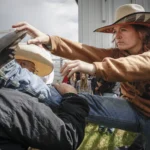FRIDAY FOCUS: ‘Devastating’ Drug Addiction and Overdose Crisis Grips Wyoming (Part 1)
State deploys strategy of enforcement, prevention, treatment and recovery to protect communities
- Published In: Other News & Features
- Last Updated: Mar 24, 2023

By Ernest Beck
Special to the Wyoming Truth
Drug overdoses are now a leading cause of death in the United States, with nearly 107,000 fatalities alone over the past 12 months. Yet, the addiction and overdose epidemic has been building for two decades in which nearly one million Americans have died in every corner of the country—including in Wyoming.
There were 93 overdose deaths recorded in Wyoming in 2022, down from 98 in 2021, compared with 65 in 2018, according to the Wyoming Department of Health (WDH). No part of the state has been spared: drug-related deaths occur in both urban and rural areas with widely dispersed populations, and also on Native American tribal lands.
To better understand the substance use and overdose crisis, the Wyoming Truth recently spoke with experts in law enforcement, treatment and recovery. First up is Casey Patterson, a former detective in the Cheyenne Police Department who is now a drug intelligence officer for the Wyoming Rocky Mountain High Intensity Drug Trafficking Areas (HIDTA) task force. This program is responsible for disrupting and dismantling drug trafficking organizations. What follows are excerpts from the interview.

Nationally, about 300 people die every day from drug overdoses. Compared with a densely populated city such as New York, where one person dies every four hours, what is the situation in Wyoming?
Patterson: With these nationwide numbers, we’re looking at a 9/11-level event every 10 days or so, and the national death rate is increasing all the time. If you adjust that on a per capita basis for little Wyoming, where the entire state’s population could fit into a corner of one New York City borough, then it certainly is a crisis.
The majority of overdose deaths generally fit the demographic of Wyoming, with more fatalities among white, middle-aged men. What other characteristics do you see?
Patterson: There are more deaths in high-population areas such as Cheyenne and Casper, but they also happen in places like Saratoga, population about 1,400, where two people [a couple] overdosed in February on the same day. It was devastating.
We’re now in the third wave of the epidemic with the influx of fentanyl, and interdictions are increasing. The federal Drug Enforcement Agency says it seized enough fentanyl in 2022 to kill every American. How bad is the problem in Wyoming?
Patterson: In our area, there are more raids and seizures of the drug than ever before—for example, 26 pounds of fentanyl were found in 2022 in Laramie County. This would be enough to kill every person in Wyoming. One reason is that Wyoming is a national corridor for drugs, with much of it coming down I-80 as people drive their contraband back home, and also along the I-25 from Denver, which feeds the eastern part of the state. These drugs are not necessarily destined for the streets of Wyoming, but [they get] here anyway because we’re on the transit route. Law enforcement continues to see this as a threat to our communities, and we are responding accordingly.
Overall, how would you describe Wyoming’s response to the overdose crisis?
Patterson: The state has put in place enforcement, prevention, and treatment and recovery measures. My job is to coordinate everything to make sure all the parties are working together. We have to talk to each other and share what’s happening and be on the same page about how to respond. And so when something terrible does take place, like the recent overdoses in Saratoga, we can make plans to prevent this from happening again, and educate the public and essential services.
More specifically, what are the most significant elements of the statewide effort?
Patterson: Narcan (the narcotic overdose reversal drug naloxone) is available at almost every pharmacy and pharmacists can distribute it without a prescription. [WDH says that 1,234 doses of Narcan have been distributed for free since August 2022 to agencies, businesses, and organizations.] In rural counties, even school nurses have first-aid kits with Narcan as well as oxygen supplies, so they can stabilize [a] patient until EMS gets there. Finally, there are fentanyl test strips, which can alert users to contaminated drugs, although the legal situation surrounding such testing equipment—and who pays for it—is complicated. [WDH says it does not currently purchase test strips but is considering options to do so.]
What other policies could be implemented in Wyoming?
Patterson: We’re one of only three states without a Good Samaritan law, which offers legal protection to people who assist others who they believe to be injured, ill or in peril. Without this, a bystander witnessing an overdose might be reluctant to dial 911, perhaps because they have drugs on them or have had a misdemeanor and don’t want to get in trouble. The best model is, if your friend is overdosing, you can call for help without fear.
Harm reduction strategies such as safe syringe sites and overdose prevention centers have long been controversial but are now gaining acceptance—and are even backed by the Biden administration. What is your opinion?
Patterson: We are part of the Office of National Drug Control Policy—working under the country’s “drug czar”—which advances a strategy that includes aspects of harm reduction. Preliminary evidence suggests that some harm reduction policies can build trust with substance users, reduce overdoses, help individuals enter treatment and provide them with assistance such as housing and jobs to re-enter society. I’m not endorsing one model or another—New York City, for example, has opened the nation’s first safe syringe sites, where users can inject drugs under supervision—and each community must choose a model that works for them. Our goal is to educate government agencies about the potential of harm reduction. [WDH says it supports evidence-based harm reduction strategies that are within state law; current statutes do not allow establishing a syringe services program.]
With the settlement of opioid lawsuits, billions of dollars will be flowing to states, including Wyoming, over the next two decades (and separately to Native American communities), allowing them to implement new anti-drug programs. Wyoming has already received nearly $4.4 million. What might be the impact?
Patterson: It could be a turning point. Also, there are safeguards in place to guarantee how the money will be spent, with the focus on education, prevention, medication-assisted treatment, outreach, training health care workers and expanding services like telehealth. Right now, the counties and stakeholders are figuring out how to write grants so they can get the money, and the state government promises to be very careful that programs are designed to reach the stated goals.
Given the huge scale of the problem, are you hopeful Wyoming can make progress?
Patterson: I hope I do this job long enough to put myself out of business. In the meantime, my job is to see what’s coming next and how it will affect the people of Wyoming. I do see trends creeping westwards that are potentially dangerous. But if we know what’s on the horizon, we can be better prepared. So if we stay alert, I am cautiously optimistic.













